American Civil War
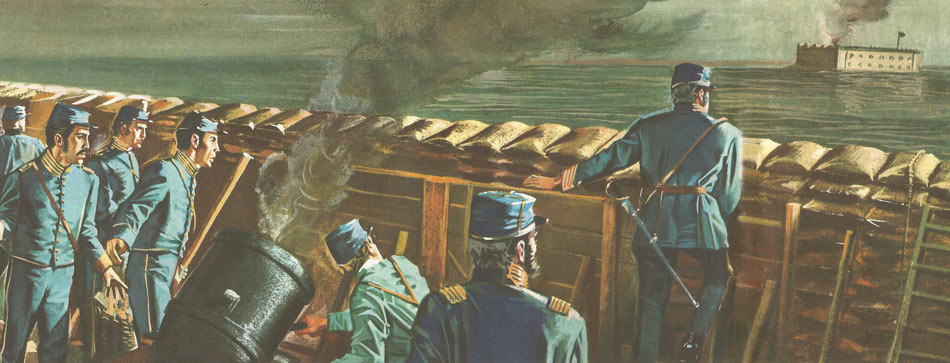
Figure 1. 12th April 1861. Confederate troops bombed Fort Sumter, above which flies the flag of the federal government. This was the first drama of the Civil War.
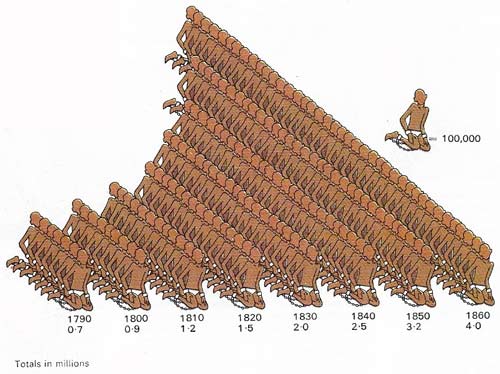
Figure 2. Black slaves made up more than a third of the population of the South when the war began. A strong, young, male slave could cost nearly $2,000 and was a substantial investment for his owner.

Figure 3. A stately mansion with stucco columns and verandas on the ground and first floors was the focal point of many Southern plantations. House slaves acted as servants while field slaves tilled the surrounding soil. Although there were fewer than 10,000 plantation owners who had 50 or more slaves in the 1850s, they wielded overwhelming political and social influence throughout the South.
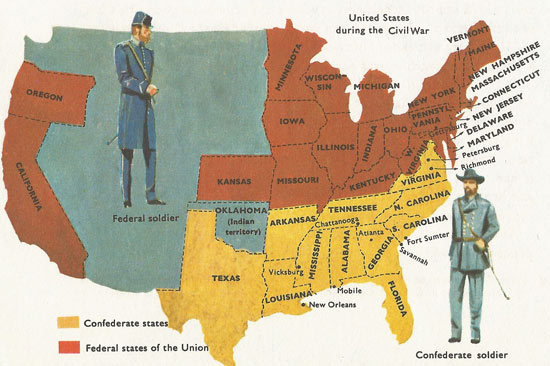
Figure 4. Confederate and Federal states. Loyalties to South or North crossed state lines and divided families during the Civil War. Three of Abraham Lincoln’s brothers-in-law died fighting for the confederacy. Of the 23 states, including California and Oregon, which were loyal to the Union, the most difficult decision fell to the “border states”, the slave states of Kentucky, Maryland and Missouri. Their allegiance to the “Stars and Stripes” proved to be stronger than their purely regional interests. Although Virginia joined the Confederacy, the western part of the state chose the Union instead and gained statehood as West Virginia before the end of the war.
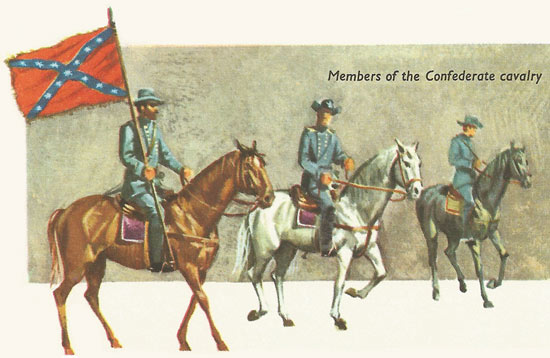
Figure 5. Members of the Confederate cavalry.
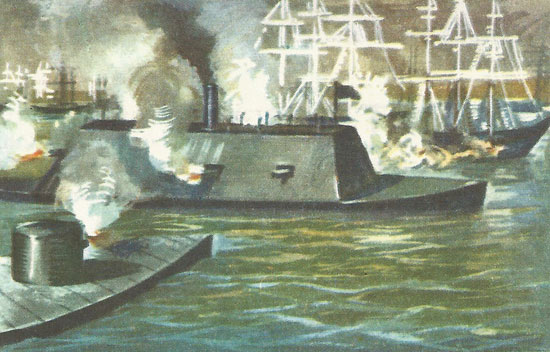
Figure 6. The huge, armored Merrimac encounters the Federal ship Monitor.
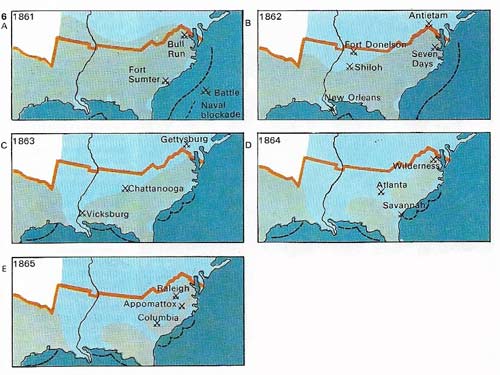
Figure 7. Erosion of Confederate territory was steady after an initial stalemate (A) in 1861 when the North realized it must blockade the South. In 1862, after victories westwards, the Union advanced from the north (B). By May 1863 it controlled the Mississippi (C). By the end of 1864 Sherman had split the South in two (D). Surrender became inevitable in 1865 after further Union gains (E).
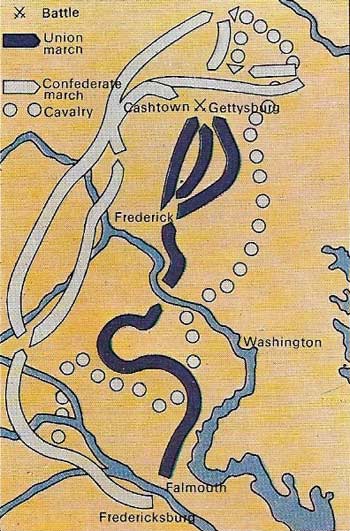
Figure 8. Gettysburg marked the turning point of the war in 1863 when a daring Confederate invasion of Pennsylvania was blocked in a ferocious three-day battle. General Lee, the Confederate commander, intended to await a Northern repulse near Cashtown. But a chance encounter between rival patrols precipitated the battle near the small town of Gettysburg on 1 July. Successful probing assaults on Union positions led Confederate officers to misread the situation and cavalry that was engaged elsewhere failed to scout the terrain. Finally three divisions of Confederate troops were sent in to a withering barrage of artillery and rifle fire.

Figure 9. Battle statistics at Gettysburg are subject of controversy, but it is likely that about 72,000 Confederate troops faced nearly 90,000 Union troops. This disparity need not have been decisive in view of earlier Confederate successes. While about 23,000 Union men were killed or died of wounds the South's losses were about 28,000 (higher than the official figure given at the time). The strength of the Union was not undermined significantly. But although its surviving forces escaped back to the South, the Confederacy had suffered a crippling and irrevocable loss. By 1865, with both sides conscripting men, the North had 960,000 under arms and the South only 450,000.
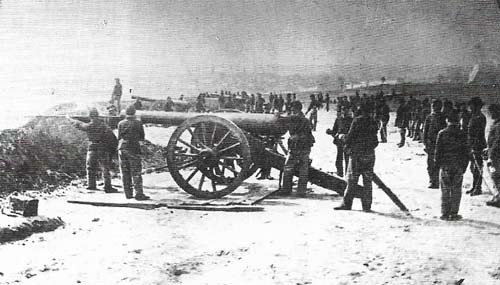
Figure 10. Union troops with a battery of 32-pounders near Fredericksburg were photographed by Matthew Brady (c. 1823–1896), one of the first war photographers in history. The Civil War was also the first conflict in which telegraphy and railroad transport were used widely and the first in which ironclad naval vessels went into battle; in March 1862 the USS Monitor and the Confederate Merrimack fought each other at Hampton Roads, Virginia. An early submarine attack was launched by Huntley which rammed its torpedo into the USS Housatonic off Charleston in 1864, with the loss of both ships.
The Civil War from 1861 to 1865 was the bloodiest and bitterest conflict the United States has ever experienced. It was, President Abraham Lincoln said, a test of whether America could endure. Although the nation emerged from it intact, the "war between brothers" left a legacy of grief and hatred. It remains a vital formative influence on one of the strongest nations in the world.
The rift between North and South had been widening for some time. In the South the wealthy landowners depended on the labor of Black slaves. But the more industrialized Northern communities were opposed to slavery. Moreover, the South condemned the economic policy of the North. In order to protect their own industries, Northern businessmen wished to restrict the import of foreign manufacturers. In addition there was the mutual antipathy of the proud, cultured Southerners for their brash 'Yankee' fellow-countrymen of the North.
In November 1860 Abraham Lincoln was elected President of the United States. He was known as a 'black republican', on account of his opposition to slavery, Although he said he would not abolish slavery in states where it existed, he was determined that it should not be extended to the new states in the west. The slave states of the South had no intention of being ruled by Lincoln, and in December 1860 South Carolina announced that she had seceded from the Union, meaning she was no longer a member of the 'United' States. By the time Lincoln was inaugurated as President, in March 1861, six other slave states – Florida, Georgia, Alabama, Mississippi, Louisiana, and Texas – all followed South Carolina. They formed a new union of their own – the Confederate States of America – and elected a distinguished soldier, Jefferson, as their President.
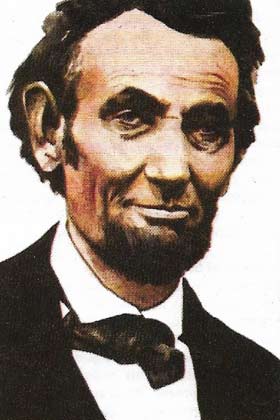 |
| Abraham Lincoln (1809–1865), United States President during the Civil War, believed the country could not survive "half slave and half free" but was determined to prevent the break-up of the Union. A self-taught lawyer of humble birth but great shrewdness, sincerity, and common sense, he gained national recognition through public debates on slavery and was elected in 1860. Mild-mannered but strong-willed, he led the North with firmness and urged "charity for all" after the South was defeated. He was assassinated by an actor, John Wilkes Booth, in Washington on 14 April 1865, soon after starting his second term of office. |
Lincoln was convinced that the Southern states had no right to leave the Union. But could he use force? The question was decided for him when in April 1861 the Confederates forced Federal troops to surrender Fort Sumter outside Charleston (Fig 1). Lincoln regarded this as an act of insurrection or revolution. He summoned 75,000 soldiers, and the North prepared to restore the Union by force. In the South, Virginia, Arkansas, Tennessee, and North Carolina joined the Confederates (Figure 4); the scene was set.
The issue of slavery
The Civil War was kindled by a conflict of interests between the northeastern and southeastern sections of the country at a time when most of the West was still being settled. The North was a major manufacturing and commercial region while the South was overwhelmingly agricultural with "King Cotton" providing most of its wealth (Figure 2). The North believed in strong central government to nourish its economic growth; the South insisted on "states' rights" to guard its regional interests. Tariffs, which the North demanded to protect its industries, were opposed by the South because they raised the prices of manufactured goods. Northern industrial expansion was able to accommodate growing numbers of free laborers, despite extremes of poverty and wealth. The South's plantation economy depended on a large workforce of black slaves (Figure 1) and it was on the slave question that North–South differences gradually came to focus.
By 1850 slavery had become the most important issue in American politics. The South considered the system proper as well as necessary; many in the North considered it abominable and held it responsible for the South's comparative economic backwardness. Congressional compromises patched up differences and delayed an open break, but the South continued to press for the extension of slavery into western territories. In the North abolitionists, of whom William Lloyd Garrison (1805–1879) was the most eloquent, agitated against the "peculiar institution" of human bondage. The influential novel of Harriet Beecher Stowe (1811–1896), Uncle Tom's Cabin (1852), dramatizing the brutalities of slavery, won support for the anti-slavery movement. The drift towards a violent resolution of sectional differences gathered momentum as hatred was whipped up by inflammatory speeches on both sides.
Both the Democratic and Whig parties, the two major national political organizations, were badly split over slavery and the Whigs proved unable to survive the internal divisions. From the ruins of their party there emerged in 1854 a new Republican Party whose presidential candidate six years later was a former Illinois congressman, Abraham Lincoln. Lincoln opposed the spread of slavery and foresaw its eventual disappearance as an economic and social system.
A month after Lincoln was elected president South Carolina, fearing an attack on the fabric of Southern society, seceded from the Union and was followed by Mississippi, Florida, Alabama, Georgia, Louisiana, and Texas. On 8 February 1861 the secessionist states proclaimed the existence of a new nation, the Confederate States of America.
Advantages of the North
On paper the South was much weaker than the North. She lacked the North's productive capacity and consisted of 11 states as opposed to 23. Her population was less than half the North's, and after secession the Confederates had to create new instruments of government and administration. And the South was far from 'solid'. Many people in Georgia, Alabama, Mississippi, and Louisiana supported the North, while the West Virginians formed a separate state and joined the Union later in the war. The South's prosperity depended upon exports, but the American navy, supporting the North, blockaded the Southern ports, so preventing the export of her staple crop, cotton. The Southerners made one attempt to gain naval supremacy. In 1863 they fitted a captured frigate with ten guns and plated it in armor. This ship, the Merrimac, caused havoc until another iron-clad ship, the Monitor, was launched by the Union against her. In their first encounter Merrimac was defeated (Figure 6).
The South did have a few advantages. Her generals were superior and her soldiers more used to handling firearms.
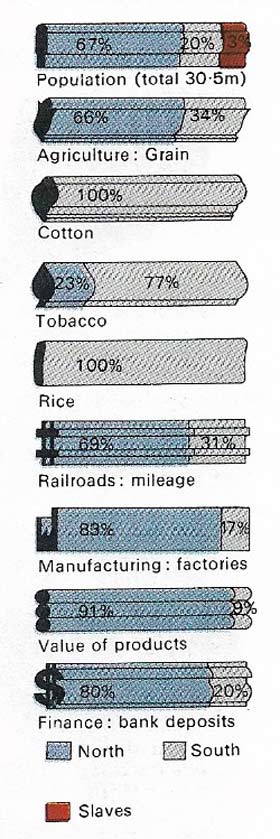 |
| Outmatched in industrial capacity, and with a much smaller population, the South counted in vain on a collapse of Northern morale. |
Invasion of the South
The Confederacy had gathered an army of 400,000, but its strategy was defensive. It fully expected France and Britain to intervene on its behalf. Yet the European countries remained neutral; the South stood alone.
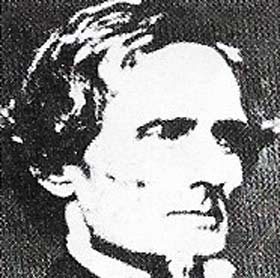 |
| Jefferson Davis (1808–1889), the champion of "states' rights" and the extension of slavery to western territory, was elected president of the Confederacy in 1861 and led the South until its surrender. |
Lincoln was faced with two main areas to attack. The Southern states were divided into east and west by the Appalachian Mountains. In the east, Virginia, which included Richmond, the Confederate capital, was all-important, and most of the eastern fighting took place there. But victory in the west would divide the Confederacy completely in two, and so was equally important.
The first major campaign of the war was disastrous for the Union. An army descended into Virginia to make an onslaught on Richmond; it met the Confederates under General Beauregard near the little stream of Bull Run and was overwhelmingly defeated. Lincoln realized that to take Virginia would be a long and arduous business.
In the west, however, events were more encouraging for the Union. Before the end of 1861 Union troops had consolidated their position in Missouri. Early the next year they marched under General Grant into Tennessee and on 6th February forced the Confederates at Fort Henry to surrender. From then on Confederate strongholds were destroyed one by one, and by 1863 Union troops were in Upper Mississippi and Alabama. Grant now left other officers to deal with the Confederates in Tennessee and concentrated on the assault of Vicksburg, the Confederate stronghold on the Mississippi. He starved the Confederate general into surrender on 14th July. Shortly afterwards Port Hudson, Louisiana, was taken by one of Grant's officers. As New Orleans had already been seized by the American navy the whole of Mississippi was now in Union hands. The South was split in two and never reunited. Meanwhile Lincoln had taken advantage of Union victories to make the momentous proclamation of 1st January 1863 abolishing slavery in the United States. This was to be the most enduring achievement for which he is remembered.
A costly war of attrition was now taking place in the east. The Virginian army under the Southern General Robert E. Lee and his able lieutenant Colonel 'Stonewall' Jackson (who had gained his nickname at the battle of Bull Run) was powerful and confident.
In 1863 Lee invaded Pennsylvania and was only stopped by a decisive defeat at Gettysburg in July. Yet in early 1864 Lee's army still appeared an insuperable barrier to Union hopes.
The final stages
In May 1864 General Grant, now commanding all Federal armies, took charge of the Virginian campaign. In a determined drive on Richmond he thrust his way south, heedless of heavy losses. He crossed the James River and laid siege to Petersburg, near Richmond. Meanwhile General Sherman had begun his campaign from Chattanooga to Atlanta. 'Marching through Georgia', he laid that state waste, destroying everything in his path. In December Savannah fell, and Sherman turned north and pushed into Virginia.
The pincers were closing in on Virginia, and the war was in its final phase. On 2nd April 1865 Petersburg fell to Grant. The next day the Unionists entered Richmond, hurriedly evacuated by the Southern President Davis. Lee's unconquered army was racing westward, slowly pursued by Grant and with another Federal army under General Sheridan on its flank. On 9th April Lee surrendered, having given up a plan to join General Johnston in North Carolina. A fortnight later Johnston surrendered, and in the west General Kirby Smith laid down his arms. The war was over.
The cost of the American Civil War was enormous. About 600,000 men were killed and hundreds of thousands wounded or crippled. The total cost of the war has been estimated at more than 20 billion dollars (in present-day terms).
The war had results of immense significance for the future. The emancipation of the slaves was ensured despite Lincoln's assassination in the year of victory, and the Union was consolidated and enabled to grow into the great nation that was to play a decisive role in world of politics in the next century. But the feelings and hatreds generated by four years of Americans fighting Americans left differences of outlook which were to prove lasting and scars which have perhaps not been fully healed to this day.
